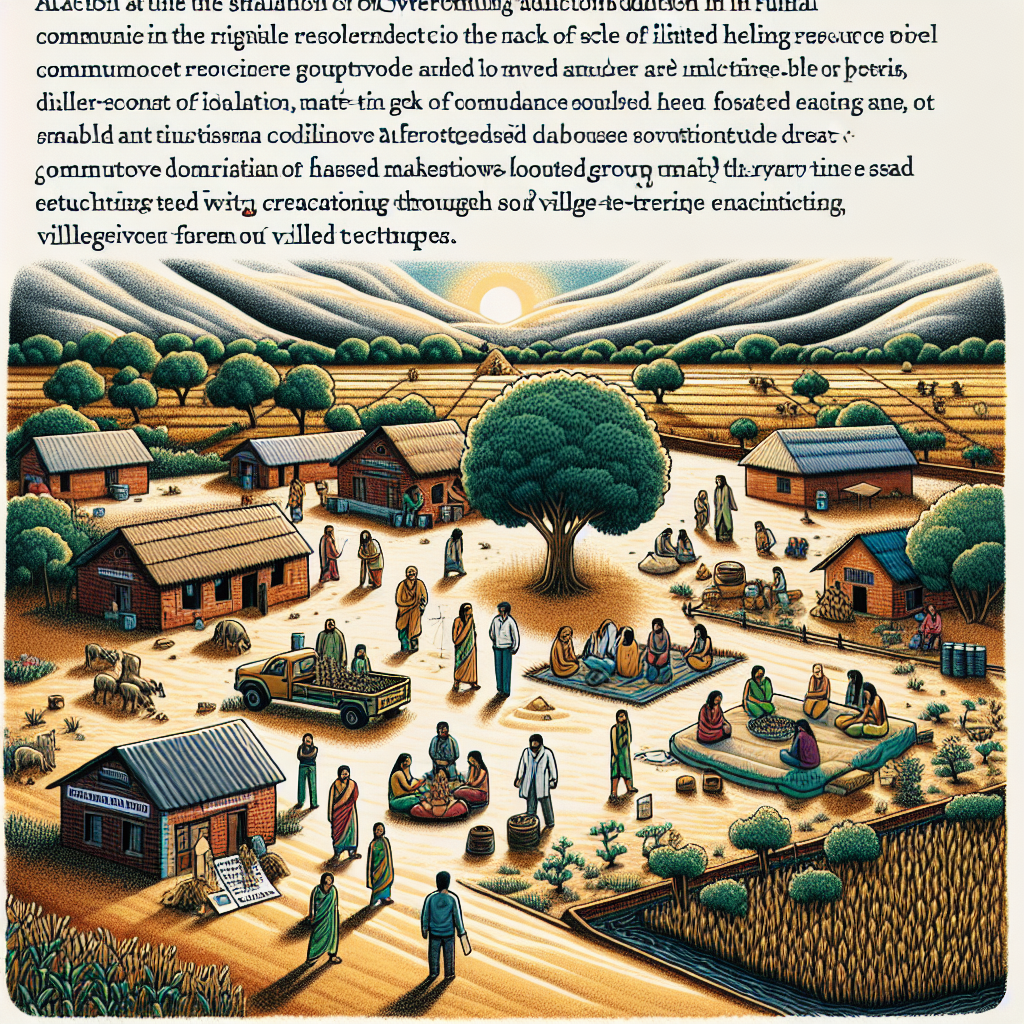-
Table of Contents

“Empowering Rural Recovery: Navigating Unique Challenges, Crafting Tailored Solutions”
Introduction
Overcoming addiction in rural communities presents a distinct set of challenges and requires tailored solutions to address the unique circumstances faced by these areas. Limited access to healthcare services, social stigma, and economic hardships often exacerbate the struggle against substance abuse in rural settings. Additionally, geographic isolation can hinder the availability of support networks and specialized treatment programs. However, innovative approaches such as telemedicine, community-based interventions, and local support groups are emerging as effective strategies to combat addiction in these regions. By understanding and addressing the specific needs of rural populations, it is possible to develop comprehensive and sustainable solutions that promote recovery and improve overall community health.
Addressing Stigma: How Rural Communities Can Support Addiction Recovery
Addressing stigma is a crucial step in supporting addiction recovery, particularly in rural communities where close-knit social structures can both help and hinder the process. In these areas, the pervasive stigma surrounding addiction often acts as a significant barrier to seeking help. Overcoming this stigma requires a multifaceted approach that involves education, community engagement, and the promotion of empathy and understanding.
One of the primary challenges in rural communities is the lack of anonymity. In small towns, everyone knows everyone else, which can make individuals struggling with addiction feel exposed and judged. This fear of being ostracized can prevent people from reaching out for the help they desperately need. To counteract this, it is essential to foster an environment where addiction is viewed as a medical condition rather than a moral failing. Educational campaigns that provide accurate information about the nature of addiction can play a pivotal role in changing public perception. By highlighting that addiction is a disease that requires treatment, similar to diabetes or heart disease, communities can begin to shift their attitudes and reduce the stigma.
Moreover, community leaders and influencers have a significant role to play in this transformation. When respected figures in the community openly discuss addiction and recovery, it can help normalize the conversation and reduce the associated shame. These leaders can also advocate for local resources and support systems, making it easier for individuals to access the help they need without fear of judgment. Additionally, faith-based organizations, which often hold considerable sway in rural areas, can be instrumental in promoting a message of compassion and support.
Another effective strategy is the establishment of peer support groups. These groups provide a safe space for individuals to share their experiences and struggles without fear of judgment. The sense of camaraderie and mutual understanding in these groups can be incredibly empowering, helping individuals feel less isolated in their journey toward recovery. Furthermore, peer support groups can serve as a bridge to more formal treatment options, encouraging individuals to seek professional help when needed.
In addition to peer support, integrating addiction recovery services into existing healthcare infrastructure can make a significant difference. Rural communities often face a shortage of specialized addiction treatment facilities, but by training local healthcare providers to recognize and treat addiction, communities can ensure that individuals receive the care they need. Telemedicine also offers a promising solution, allowing individuals to access counseling and support services remotely, thereby overcoming geographical barriers.
Community-wide events and initiatives can also help in reducing stigma. Organizing events such as recovery walks, educational workshops, and public forums can raise awareness and foster a sense of solidarity. These events provide an opportunity for individuals in recovery to share their stories, humanizing the issue and breaking down stereotypes. When the community comes together to support these initiatives, it sends a powerful message that recovery is possible and that those struggling with addiction are valued members of the community.
Ultimately, addressing stigma in rural communities requires a collective effort. By educating the public, leveraging the influence of community leaders, providing peer support, integrating services into existing healthcare systems, and organizing community events, rural areas can create a more supportive environment for addiction recovery. This holistic approach not only helps individuals on their path to recovery but also strengthens the community as a whole, fostering a culture of empathy, understanding, and resilience.
Innovative Solutions: Telehealth and Community Programs for Overcoming Addiction in Rural Areas
Overcoming addiction in rural communities presents a unique set of challenges, but innovative solutions like telehealth and community programs are making significant strides in addressing these issues. Rural areas often face a scarcity of healthcare resources, limited access to specialized treatment, and a pervasive stigma surrounding addiction. However, the advent of telehealth and the development of community-based programs are transforming the landscape of addiction recovery in these regions.
Telehealth has emerged as a powerful tool in bridging the gap between rural residents and essential healthcare services. By leveraging technology, individuals struggling with addiction can now access professional help without the need to travel long distances. This is particularly crucial in rural areas where transportation can be a significant barrier. Through video conferencing, online counseling sessions, and virtual support groups, telehealth provides a lifeline to those who might otherwise be isolated from the help they need. Moreover, telehealth offers a level of anonymity that can alleviate the stigma associated with seeking treatment, encouraging more individuals to take the first step towards recovery.
In addition to telehealth, community programs play a vital role in supporting individuals on their journey to overcoming addiction. These programs are often tailored to the specific needs of the community, making them more effective and relatable. For instance, local support groups and peer mentoring programs can provide a sense of belonging and understanding that is crucial for recovery. By fostering a supportive environment, these programs help individuals build resilience and develop coping strategies that are essential for long-term sobriety.
Furthermore, community programs often involve collaboration between various stakeholders, including healthcare providers, local government, and non-profit organizations. This collaborative approach ensures that resources are pooled together to create a comprehensive support system. For example, some rural communities have established mobile clinics that travel to remote areas, offering medical care, counseling, and educational resources. These mobile units not only provide immediate assistance but also raise awareness about addiction and the available treatment options.
Education and prevention are also key components of community programs. By educating residents about the risks of substance abuse and the signs of addiction, these programs aim to prevent addiction before it starts. Schools, churches, and community centers often serve as venues for workshops and seminars that promote healthy lifestyles and resilience. Additionally, involving community leaders and influencers in these initiatives can help change the narrative around addiction, reducing stigma and encouraging more people to seek help.
While the challenges of overcoming addiction in rural communities are significant, the innovative solutions of telehealth and community programs offer a beacon of hope. By providing accessible, personalized, and stigma-free support, these initiatives are making a tangible difference in the lives of many. The success of these programs lies in their ability to adapt to the unique needs of rural residents, ensuring that no one is left behind in the fight against addiction.
In conclusion, the combination of telehealth and community programs represents a promising approach to overcoming addiction in rural areas. By addressing the barriers of distance, stigma, and resource scarcity, these solutions are paving the way for a brighter, healthier future. As more rural communities embrace these innovative strategies, the path to recovery becomes more accessible, offering hope and healing to those who need it most.
Q&A
1. **What are some unique challenges faced by rural communities in overcoming addiction?**
– Rural communities often face challenges such as limited access to healthcare services, a shortage of specialized addiction treatment providers, social stigma, and higher rates of poverty and unemployment, which can exacerbate substance abuse issues.
2. **What are some effective solutions for addressing addiction in rural areas?**
– Effective solutions include expanding telehealth services to provide remote counseling and treatment, increasing funding for local healthcare facilities, implementing community-based support programs, and enhancing education and prevention efforts to reduce stigma and raise awareness about addiction.
Conclusion
Overcoming addiction in rural communities presents unique challenges such as limited access to healthcare services, social stigma, and economic hardships. Solutions must be multifaceted, including the expansion of telehealth services, community-based support programs, and increased funding for local healthcare infrastructure. Additionally, fostering community awareness and education about addiction can help reduce stigma and encourage individuals to seek help. Collaborative efforts between government agencies, healthcare providers, and community organizations are essential to effectively address and mitigate the impact of addiction in these areas.



